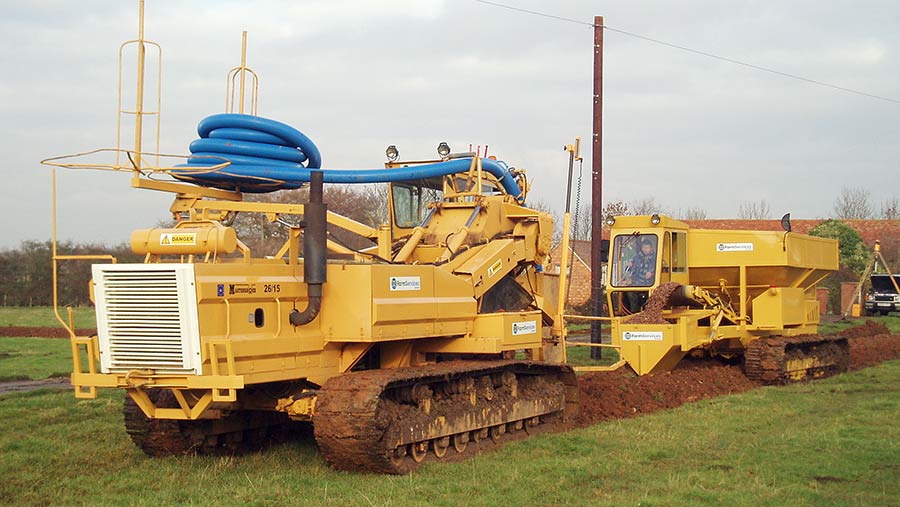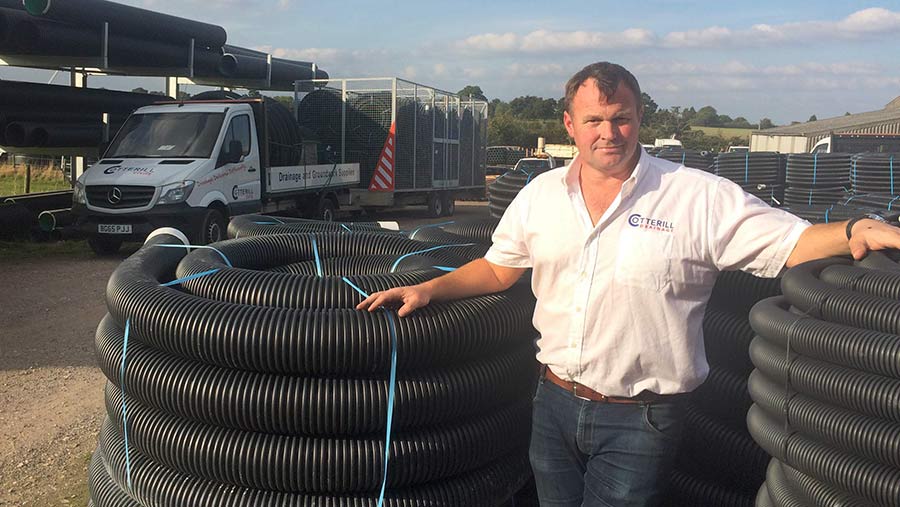A guide to assessing and improving grassland drainage
 © Farm Services
© Farm Services Up to 70% of grassland farms could benefit from improved field drainage, according to Adas national specialist Kirk Hill.
One in 10 pastures is severely compacted and soil moisture issues are the most common reason for swards to fail, Mr Hill says.
Plant roots need oxygen to grow, and within a well-structured, well-drained soil, air is held in pockets.
See also: A guide to soil mapping and variable rate fertiliser
These gaps and fissures allow water to pass down through the layers into a drainage system.
But when that system becomes blocked, or the soil is compressed by animal movements and machinery, water can no longer move down and away.
In compacted soils, grass roots are asphyxiated in trapped water or blocked by impenetrable soil layers.
Above the ground it is not only the obvious standing water that indicates poor drainage, but yellowing grass, poor yields and failing patches of maize or stubble turnips.
Drainage installation benefits
- Promotes good soil structure for root development
- Extends the growing or grazing season
- Allows better access to land with machinery
- Reduces soil compaction
- Cuts fuel use through improved traction
- Increases work window for field operations
- Improves conditions for livestock
- Reduces risk of infection.
Source: Cotterill Civils/AHDB Field Drainage Guide
The pitfalls of poor drainage
Poor drainage can cause issues such as:
Plant establishment and growth:
Plants need good root growth to take up nutrients, so any stunting of root structure through compaction or waterlogging will limit growth.
The weakened plants are then more susceptible to disease, requiring more inputs of fertiliser or chemical controls to maintain them.
Nutrient losses and pollution:
Surface water will also cause nutrient losses through leaching. Heavy rainfall carries away the nutrients, soil and organic matter which can cause pollution of watercourses.
This in turn may lead to cross-compliance breaches and support payment penalties or even fines, particularly in catchment sensitive areas.
Access difficulties:
Access to the land may become more limited for stock and vehicles than would be expected, says Mr Hill.
Where this is the case, a good drainage system can extend access by a month at each end of the growing season.
Animal health and welfare issues: The UK spends £23m a year treating liver fluke, which is harboured by small snails in standing water.
If that water is removed, the life cycle of the liver fluke is broken, cutting the cost of treatment and improving animal welfare.
Likewise, foul of the foot is the result of bacteria entering the foot through cracks in the skin caused by dirty, wet conditions.
Teagasc estimates that a single case in a dairy cow can bring costs of up to £260 in treatment and lost milk yield.
Udder hygiene is also compromised in wet, muddy soil, allowing bacteria to take hold, again causing infection and significant losses of up to £250 a cow.
Assessing drainage issues
The causes of poor drainage beneath the soil can vary.
One issue may be a soil pan. Pans can occur naturally in heavy soils where bands become fused together by iron or manganese.
This may look like mottles or rust in a grey clay soil. They can also be caused by compaction from traffic or occur just below the ploughing depth.
A quick way to assess where the problem lies is to pull up a dock.
When the tap roots bend horizontally it indicates there is an impenetrable pan beneath it, which is likely to be preventing the water from reaching the drainage system.
But this is only an indicator and it is essential to get a better idea of the scale of the problem by digging inspection pits.
Inspection pits should be dug in various places across the field to a depth of at least 50cm. Digging just after there has been some rain will help to identify problem areas more quickly.
Poorly drained land may be so highly compacted that a pit will reveal that moisture is penetrating to only a few millimetres below the surface.
If the water passes further down it may begin to fill the pit at a certain depth, indicating where a pan lies.
If you keep digging until you reach dry ground you can then see where the water is collecting, Mr Hill says.
Another indicator of poor drainage is a bluey-grey level in the clay that smells of sulphur, which indicates where water has been collecting.
Where poor drainage is identified it is time to call in a consultant and a dedicated drainage contractor who can recommend a course of action.
Tackling poor drainage
Despite the alarming appearance of standing water in a field it is often not necessary to install an entirely new system, says specialist drainage engineer Andy Cotterill.
The first place to look for a problem is the outfall into the water course, says Mr Cotterill, managing director of Midlands-based Cotterill Civils.
The outfall should be at the lowest point in the field and run into the ditch.
Make sure the receiving watercourse or ditch is cleaned out below the depth of the outfall and that the watercourse is maintained further downstream so that it cannot back up in the winter, he says.
Even if the outfall is dry, indicating the system is blocked, it may prove to be only one small area that is affected.
Removing that blockage or breaking up an area of compaction with a subsoiler or mole drain can free up the whole system relatively inexpensively.
Moling interconnects the drainage scheme where it has been backfilled with stone at centres of about 2.75m across the field.
But mole draining assumes you know where the existing system lies.
It is well worth taking time to find the drainage maps because, as well as the layout of the pipework, it includes information such as gravel depth.
This indicates the ideal depth and direction for any mole drain work to be carried out.

Andy Cotterill stresses the other cost benefits of an efficient drainage system, such as better animal health
A trial dig will also reveal whether the drain has sunk and, if so, mole drain depths should be adjusted.
If there is no system, the long-term benefits make it worth installing one.
See: How, why and when to mole drain
Installing a new drainage system
The first step towards this is to make a topographical survey of the site using a quadbike-mounted GPS device, Mr Cotterill explains.
The GPS plots the position and the land height at about 40-50m centres. This provides data for 3D computer modelling software to create the optimum location and depths for drains.
Contractors will cover about 4ha a day where land and access allow the machinery to manoeuvre.
The cost is about £3,000/ha, Mr Cotterill reckons.
Many people will baulk at that, but increasing the grass yield for grazing and forage, cutting vet bills and improving access to fields can make it a worthwhile investment.
With land prices for grassland at about £20,000/ha, improving existing land or bringing it into production is cost-effective, he adds.
Top 5 tips for maintaining land drainage
- Check watercourse is clear from silt and debris
- Check outfalls are running freely
- Check soil structure
- Undertake mole draining every five years
- Tackle poor drainage immediately – it will only get worse if left.
Source: Cotterill Civils
